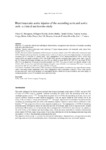Mostrar o rexistro simple do ítem
Blunt traumatic aortic injuries of the ascending aorta and aortic arch: a clinical multicentre study
| dc.contributor.author | Mosquera Rodríguez, Víctor Xesús | |
| dc.contributor.author | Marini Díaz, Milagros | |
| dc.contributor.author | Muñiz, Javier | |
| dc.contributor.author | Gulias, Daniel | |
| dc.contributor.author | Asorey-Veiga, Vanesa | |
| dc.contributor.author | Adrio-Nazar, Belén | |
| dc.contributor.author | Herrera, José M. | |
| dc.contributor.author | Pradas-Montilla, Gonzalo | |
| dc.contributor.author | Cuenca, José J. | |
| dc.date.accessioned | 2015-06-22T10:26:27Z | |
| dc.date.available | 2015-06-22T10:26:27Z | |
| dc.date.issued | 2012 | |
| dc.identifier.citation | Mosquera VX, Marini M, Muñiz J, et al. Blunt traumatic aortic injuries of the ascending aorta and aortic arch: a clinical multicentre study. Injury. 2013;44(9):1191-1197 | es_ES |
| dc.identifier.uri | http://hdl.handle.net/2183/14712 | |
| dc.description.abstract | [Abstract] Objective. To report the clinical and radiological characteristics, management and outcomes of traumatic ascending aorta and aortic arch injuries. Methods. Historic cohort multicentre study including 17 major trauma patients with traumatic aortic injury from January 2000 to January 2011. Results. The most common mechanism of blunt trauma was motor-vehicle crash (47%) followed by motorcycle crash (41%). Patients sustaining traumatic ascending aorta or aortic arch injuries presented a high proportion of myocardial contusion (41%); moderate or greater aortic valve regurgitation (12%); haemopericardium (35%); severe head injuries (65%) and spinal cord injury (23%). The 58.8% of the patients presented a high degree aortic injury (types III and IV). Expected in-hospital mortality was over 50% as defined by mean TRISS 59.7 (SD 38.6) and mean ISS 48.2 (SD 21.6) on admission. Observed in-hospital mortality was 53%. The cause of death was directly related to the ATAI in 45% of cases, head and abdominal injuries being the cause of death in the remaining 55% cases. Long-term survival was 46% at 1 year, 39% at 5 years, and 19% at 10 years. Conclusions. Traumatic aortic injuries of the ascending aorta/arch should be considered in any major thoracic trauma patient presenting cardiac tamponade, aortic valve regurgitation and/or myocardial contusion. These aortic injuries are also associated with a high incidence of neurological injuries, which can be just as lethal as the aortic injury, so treatment priorities should be modulated on an individual basis. | es_ES |
| dc.language.iso | eng | es_ES |
| dc.publisher | Elsevier | es_ES |
| dc.relation.uri | http://dx.doi.org/10.1016/j.injury.2012.12.011 | es_ES |
| dc.rights | Creative Commons Licence | es_ES |
| dc.rights | Reconocimiento-NoComercial-SinObraDerivada 4.0 Internacional | |
| dc.rights.uri | http://creativecommons.org/licenses/by-nc-nd/4.0/ | |
| dc.subject | Aorta | es_ES |
| dc.subject | Aortic arch | es_ES |
| dc.subject | Trauma surgery | es_ES |
| dc.subject | Emergency | es_ES |
| dc.title | Blunt traumatic aortic injuries of the ascending aorta and aortic arch: a clinical multicentre study | es_ES |
| dc.type | info:eu-repo/semantics/article | es_ES |
| dc.rights.access | info:eu-repo/semantics/openAccess | es_ES |
Ficheiros no ítem
Este ítem aparece na(s) seguinte(s) colección(s)
-
GI- GRINCAR - Artigos [216]






